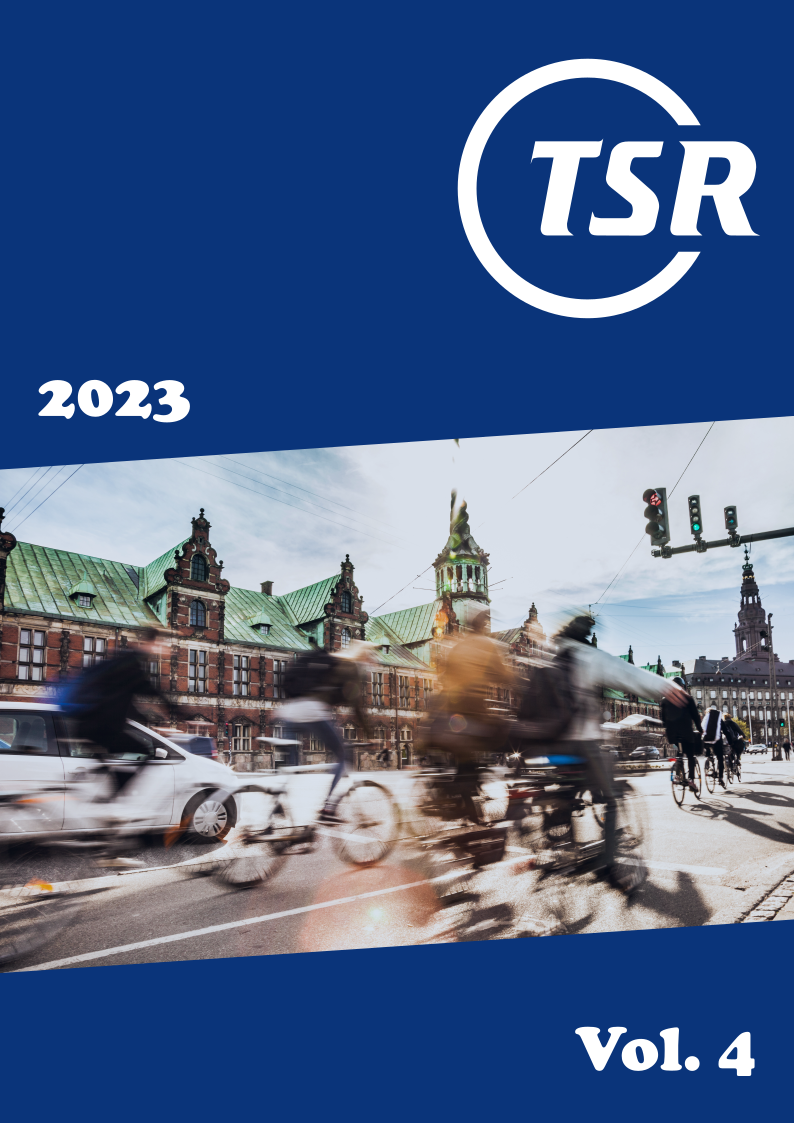Cumulative lateral position: a new measure for driver performance in curves
DOI:
https://doi.org/10.55329/xmls1738Keywords:
curve design, curve, driving, geometry, lateral control, measure, SDLPAbstract
Vehicle control can be described with lateral and longitudinal control measures. The Standard Deviation of Lateral Position (SDLP) is probably the most common measure to reflect lateral control. Indices such as mean Lateral Position (MLP) and Time-to-Line Crossing (TLC) have also been used to describe driver behaviour. Even though all these measures have demonstrated their value, in some specific cases, these measures may indicate that driver behaviour is deteriorated while that may not necessarily be the case. When negotiating curves for example, most drivers prefer to not to follow the centre of the lane. We propose a new index, called the Cumulative Lateral Position (CLP), an index that does not suffer from drawbacks of the earlier mentioned measures in these conditions. We also applied the CLP in a practical case. In a simulator experiment drivers negotiated three types of curves: traditional circular (CIR), clothoid (CLO), and a new curve, a polynomial curve with continuous curvature (CON). Results show that the CLP index, unlike the older measures, is able to well summarise the trajectory on a road curve and is sensitive in distinguishing different driving behaviour with respect to variations in road geometry, even in cases where these differences are small. The proposed methodology can be used to evaluate both new and existing roads design solutions, and showed in this experiment that driving behaviour was safest in the continuous curve.
Downloads
References
Barendswaard, S., D. M. Pool, E. R. Boer, D. A. Abbink (2019), ‘A Classification Method for Driver Trajectories during Curve-Negotiation’, presented at 2019 IEEE International Conference on Systems, Man and Cybernetics (SMC) (Bari, Italy: 6–9 October 2019), https://doi.org/10.1109/smc.2019.8914301.
Barenswaard, S. (2021), ‘Modelling Individual Driver Trajectories to Personalise Haptic Shared Steering Control in Curves’, PhD thesis, Delft University of Technology, Cognitive Robotics, https://doi.org/10.4233/uuid:7292e35d-d45a-4ad1-9663-ae2b5c5a9f16, accessed 11 December 2022.
Boer, E. R. (2016), ‘Satisficing Curve Negotiation: Explaining Drivers’ Situated Lateral Position Variability’, IFAC-PapersOnLine, 49 (19), 183–188, https://doi.org/10.1016/j.ifacol.2016.10.483.
Bosurgi, G., A. D’Andrea (2012), ‘A Polynomial Parametric Curve (PPC-CURVE) for the Design of Horizontal Geometry of Highways’, Computer-Aided Civil and Infrastructure Engineering, 27 (4), 304–a312, https://doi.org/10.1111/j.1467-8667.2011.00750.x.
Bosurgi, G., O. Pellegrino, G. Sollazzo (2016), ‘Using Genetic Algorithms for Optimizing the PPC in the Highway Horizontal Alignment Design’, Journal of Computing in Civil Engineering, 30 (1), https://doi.org/10.1061/(asce)cp.1943-5487.0000452.
Brookhuis, K. A. (2014), ‘The role of traffic psychology in psychopharmacological research’, Transportation Research Part F: Traffic Psychology and Behaviour, 25, 120–126, https://doi.org/10.1016/j.trf.2013.10.011.
van Dijken, J. H., J. L. Veldstra, A. J. A. E. van de Loo, et al. (2020), ‘The influence of alcohol (0.5‰) on the control and manoeuvring level of driving behaviour, finding measures to assess driving impairment: A simulator study’, Transportation Research Part F: Traffic Psychology and Behaviour, 73, 119–127, https://doi.org/10.1016/j.trf.2020.06.017.
Godthelp, H., P. Milgram, G. J. Blaauw (1984), ‘The Development of a Time-Related Measure to Describe Driving Strategy’, Human Factors: The Journal of the Human Factors and Ergonomics Society, 26 (3), 257–268, https://doi.org/10.1177/001872088402600302.
Godthelp, H. (1988), ‘The limits of path error-neglecting in straight lane driving’, Ergonomics, 31 (4), 609–619, https://doi.org/10.1080/00140138808966703.
Italian Road Standard (2001), ‘Functional and geometric standards for road construction’ (5 November 2001), Ministerial Decree, n. 6792.
Michon, J. A. (1985), ‘A Critical View of Driver Behavior Models: What Do We Know, What Should We Do?’, in Evans, L., R. C. Schwing (eds.), Human Behavior and Traffic Safety (Boston, MA: Springer), 485–524, https://doi.org/10.1007/978-1-4613-2173-6_19.
O'Hanlon, J. F. (1984), ‘Driving performance under the influence of drugs: rationale for, and application of, a new test’, British Journal of Clinical Pharmacology, 18 (Suppl 1), 121S–129S, https://doi.org/10.1111/j.1365-2125.1984.tb02590.x.
Ramaekers, J. G. (2003), ‘Antidepressants and Driver Impairment: Empirical Evidence From a Standard On-the-Road Test’, The Journal of Clinical Psychiatry, 64 (1), 20–29, https://doi.org/10.4088/jcp.v64n0106.
Rosey, F., J.-M. Auberlet (2012), ‘Trajectory variability: Road geometry difficulty indicator’, Safety Science, 50 (9), 1818–1828, https://doi.org/10.1016/j.ssci.2012.04.003.
Veldstra, J. L., K. A. Brookhuis, D. de Waard, et al. (2012), ‘Effects of alcohol (BAC 0.5‰) and ecstasy (MDMA 100 mg) on simulated driving performance and traffic safety’, Psychopharmacology, 222 (3), 377–390, https://doi.org/10.1007/s00213-011-2537-4.
Verster, J. C., T. Roth (2012), ‘Predicting psychopharmacological drug effects on actual driving performance (SDLP) from psychometric tests measuring driving-related skills’, Psychopharmacology, 220 (2), 293–301, https://doi.org/10.1007/s00213-011-2484-0.
Widyanti, A., A. Johnson, D. de Waard (2013), ‘Adaptation of the Rating Scale Mental Effort (RSME) for use in Indonesia’, International Journal of Industrial Ergonomics, 43 (1), 70–76, https://doi.org/10.1016/j.ergon.2012.11.003.
van Winsum, W., H. Godthelp (1996), ‘Speed Choice and Steering Behavior in Curve Driving’, Human Factors: The Journal of the Human Factors and Ergonomics Society, 38 (3), 434–441, https://doi.org/10.1518/001872096778701926.
van Winsum, W., K. A. Brookhuis, D. de Waard (2000), ‘A comparison of different ways to approximate time-to-line crossing (TLC) during car driving’, Accident Analysis & Prevention, 32 (1), 47–56, https://doi.org/10.1016/s0001-4575(99)00048-2.
Zijlstra, F. R. H. (1993), ‘Efficiency in work behavior. A design approach for modern tools’, PhD thesis, Delft University of Technology, Industrial Design Engineering, http://resolver.tudelft.nl/uuid:d97a028b-c3dc-4930-b2ab-a7877993a17f, accessed 17 December 2022.
Downloads
Published
How to Cite
Issue
Section
License
Copyright (c) 2022 Nicola Bongiorno, Orazio Pellegrino, Arjan Stuiver, Dick de Waard

This work is licensed under a Creative Commons Attribution 4.0 International License.











